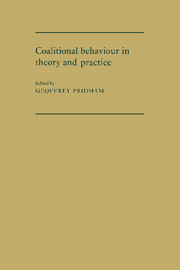Book contents
- Frontmatter
- Contents
- List of illustrations
- List of tables
- Notes on the contributors
- Preface
- 1 An inductive theoretical framework for coalitional behaviour: political parties in multi-dimensional perspective in Western Europe
- 2 Between theoretical elegance and political reality: deductive models and cabinet coalitions in Europe
- 3 Changing coalitional preferences among West German parties
- 4 The FDP and coalitional behaviour in the Federal Republic of Germany: multi-dimensional perspectives on the role of a pivotal party
- 5 Cabinet stability in the French Fourth Republic: the Ramadier coalition government of 1947
- 6 Coalition formation and maintenance in Belgium: a case-study of elite behaviour and changing cleavage structure, 1965–1981
- 7 The Dutch Christian Democratic party and coalitional behaviour in the Netherlands: a pivotal party in the face of depillarisation
- 8 Coalition or Fianna Fail? The politics of inter-party government in Ireland
- 9 Italy's party democracy and coalitional behaviour: a case-study in multi-dimensionality
- 10 Party coalitions in the first democratic period in Spain, 1977–1982
- 11 Coalitional theory and practice in Scandinavia
- 12 Multi-dimensional approaches to the study of local coalitions: some cross-national comparisons
- 13 Research notes
- Index
3 - Changing coalitional preferences among West German parties
Published online by Cambridge University Press: 05 November 2011
- Frontmatter
- Contents
- List of illustrations
- List of tables
- Notes on the contributors
- Preface
- 1 An inductive theoretical framework for coalitional behaviour: political parties in multi-dimensional perspective in Western Europe
- 2 Between theoretical elegance and political reality: deductive models and cabinet coalitions in Europe
- 3 Changing coalitional preferences among West German parties
- 4 The FDP and coalitional behaviour in the Federal Republic of Germany: multi-dimensional perspectives on the role of a pivotal party
- 5 Cabinet stability in the French Fourth Republic: the Ramadier coalition government of 1947
- 6 Coalition formation and maintenance in Belgium: a case-study of elite behaviour and changing cleavage structure, 1965–1981
- 7 The Dutch Christian Democratic party and coalitional behaviour in the Netherlands: a pivotal party in the face of depillarisation
- 8 Coalition or Fianna Fail? The politics of inter-party government in Ireland
- 9 Italy's party democracy and coalitional behaviour: a case-study in multi-dimensionality
- 10 Party coalitions in the first democratic period in Spain, 1977–1982
- 11 Coalitional theory and practice in Scandinavia
- 12 Multi-dimensional approaches to the study of local coalitions: some cross-national comparisons
- 13 Research notes
- Index
Summary
Introduction
In 1949, deputies often parties and three independents were elected into the first Bundestag (federal legislature) of the Federal Republic. At that time, it was by no means clear whether the high fractionalisation that had been characteristic of the Weimar Reichstag would continue in the new legislature. However, Adenauer was able to form a government coalition including only three parties which disposed of 52 per cent majority of the seats. Throughout the fifties, a process of concentration among the political parties represented in the Bundestag took place, which reduced the number to four in 1957 and to three in 1961. It is only since 1983 that, with the newly founded Green party (Die Grünen), a fourth party came again into the game. Nevertheless, only once, in 1957, did the Christian Democrats win an absolute majority in the Bundestag, and coalition governments have been the rule.
In this chapter, I shall limit myself to studying the coalitional behaviour of the political parties in the period between 1968 and 1982, when only three parties played a significant role in West Germany, i.e. the Christian Democratic party (CDU/CSU), the Social Democratic party (SPD) and the liberal Free Democratic party (FDP). Under the conditions of this party system, aside from the possibility of an all-party coalition which was never formed, three coalitions of two parties are possible and have in fact come into existence.
- Type
- Chapter
- Information
- Coalitional Behaviour in Theory and PracticeAn Inductive Model for Western Europe, pp. 45 - 71Publisher: Cambridge University PressPrint publication year: 1986
- 3
- Cited by

